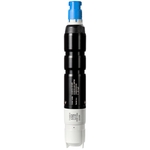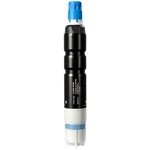Chlorine dioxide or free chlorine levels are determined according to the amperometric measuring principle.
The chlorine dioxide (ClO2) contained in the medium diffuses through the sensor membrane and is reduced to chloride ions (Cl-) at the working electrode. At the counter electrode, silver is oxidized to silver chloride.
Electron donation at the working electrode and electron acceptance at the counter electrode causes a current to flow which is proportional to the concentration of chlorine dioxide in the medium. For chlorine dioxide, this process does not depend on the pH value over a wide range. For free chlorine, however, the process depends on the pH value. That's why measurement of free chlorine must always include a pH measurement for compensation.
The amperometric measurement of disinfectants such as bromine and ozone functions in a similar way. Here, bromine and ozone molecules diffuse through the sensor membranes and are reduced.
Transcription de la vidéo
Chlorine Measurement: Understanding the Principle
Many liquids are essential in our daily life.
They may include water, beverages, dairy products, chemicals, acids and bases or pharmaceutical products.
The quality of these liquids is determined by their chemical and physical properties. To assess these properties, various principles of measurement are used. One of these principles is the measurement of the chlorine content in liquids to assess the disinfection capacity.
Disinfection destroys pathogens such as bacteria or fungi and prevents the spread of diseases. Chlorine is involved in various chemical reactions during the production process, making it crucial for industry and public health outcomes. It is accomplished by applying either free chlorine or chlorine dioxide, ozone, or ultraviolet radiation to the water. Maintaining chlorine residuals is essential in various water treatment processes to ensure safe drinking water.
Free chlorine, also known as hypochlorous acid, is the most important disinfectant in water treatment since it has a strong disinfectant effect, is almost odorless, and provides a depot effect.
In 1908, Jon L. Leal, American physicist, developed the first regular chlorination of public water supply in New Jersey, and could achieve a drastic decrease of water-borne diseases.
Let’s have a closer look at disinfection using free chlorine. In drinking water treatment, various chlorination strategies are employed to ensure safe distribution and consumption. The disinfection capacity and the chemical equilibrium of free chlorine depend on the pH value of the water. If the pH value is above 8, free chlorine is no longer sufficiently effective. At pH values below 4, even dangerous chlorine gas is released. The highest effectiveness of free chlorine is achieved between pH 4 and 8. A parallel pH measurement for compensation prevents distorted measured values.
Free chlorine measurement can be determined using the amperometric or photometric measuring principles, and it is crucial for maintaining disinfectant levels in water distribution systems. In case of photometric measurement, a reagent is mixed with the water sample. This reagent reacts with the free chlorine which results in a specific reddish sample color. The more free chlorine that is available the higher is the color intensity. This color intensity is then measured, based on the fact that the reddish color absorbs, or attenuates, light of a specific wavelength. Potassium iodide is often used in chlorine testing methods, particularly in the DPD method for measuring total chlorine.
Let’s now concentrate on the amperometric measuring principle. An amperometric sensor usually consists of a gold cathode, also called working electrode and a silver/silver chloride electrode that forms the anode.
A DC voltage is applied to both electrodes. Cathode and anode are located in a reaction chamber that is filled with an electrolyte. A membrane separates the reaction chamber from the medium to be measured. The membrane is made of a super-hydrophobic PVDF. It allows gaseous free chlorine to diffuse while it repels hypochlorite ions due to their negative charge. The membrane shows a behavior similar to cell membranes of bacteria for example.
When the sensor is immersed in a medium containing free chlorine, the HOCl molecules diffuse through the sensor membrane and are reduced to chloride ions at the gold cathode in the reaction chamber. At the anode, silver reacts to silver chloride releasing electrons. This results in a current flowing through the discharge system that is connected to the anode and cathode. This current is proportional to the concentration of free chlorine.
The current is processed in the transmitter and displayed as concentration in mg/l. When measuring free chlorine, the pH value must also be determined to compensate for the pH-dependent dissociation of free chlorine. If the pH compensation of the transmitter is activated, the pH value is included according to the preset curve and the transmitter displays true measured values.
The amperometric measuring principle enables a continuous measurement of the chlorine concentration and requires very low maintenance. Free chlorine residual is necessary to neutralize potential contaminants during distribution and ensure effective disinfection. Chlorine monitoring helps to optimize chlorine dosing including marginal chlorination and super chlorination/dechlorination and reduces operating costs.
Chlorine measurement is essential for safe water disinfection in many applications such as legally required disinfection of wastewater, disinfection of drinking water, seawater desalination, in power plants, disinfection of packaged food or cans and multiple-use bottles, and in swimming pool water. Measuring total residual chlorine is important in municipal wastewater treatment to ensure safe discharge into natural water bodies.
What is chlorine?
Chlorine is a chemical element with the symbol Cl and atomic number 17. At room temperature, it exists as a yellow-green gas and belongs to the halogen group in the periodic table. Due to its position in the periodic table, chlorine is highly reactive and is commonly found in nature as ionic compounds. It is abundantly present in the earth’s crust and seawater, often in the form of brine. Commercially, most elemental chlorine is produced from brine through processes such as electrolysis, making it readily available for various industrial and disinfection applications.
Types of chlorine in water
In water treatment, chlorine can exist in three forms: free chlorine, combined chlorine, and total chlorine. Free chlorine refers to the chlorine available to actively sanitize and kill harmful pathogens like bacteria and viruses. Combined chlorine, on the other hand, is formed when free chlorine reacts with organic matter or ammonia in the water, resulting in compounds that are less effective as disinfectants. Total chlorine is the sum of both free chlorine and combined chlorine. Understanding these distinctions is crucial for effective water treatment and ensuring the safety and quality of the water supply.
Measuring chlorine concentration
Accurately measuring chlorine concentration is essential to ensure the effectiveness of water treatment and disinfection processes. One widely used technique is the DPD method, which involves adding a reagent to the water sample and observing the resulting color change. This method can measure free chlorine, combined chlorine, chlorine dioxide, and total chlorine. Other techniques include using test strips, which offer a simple and quick way to measure chlorine levels, though they may not be as precise. Colorimeters, which measure the amount of colored light absorbed by a sample, and amperometric inline sensors / online analyzers, which provide continuous real-time measurements, are also commonly used in various applications.











